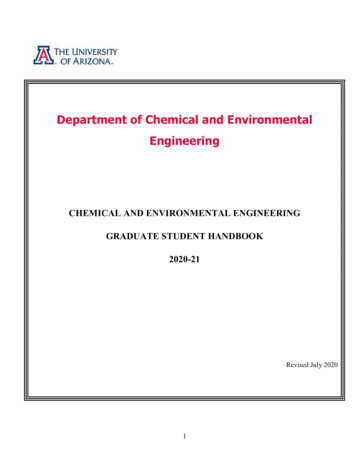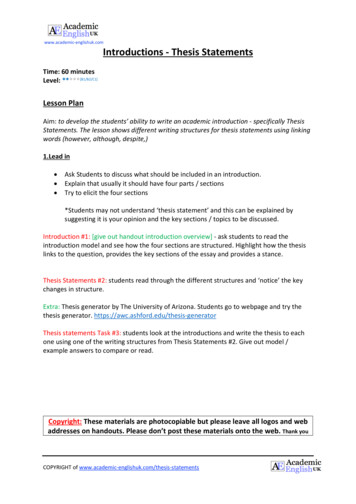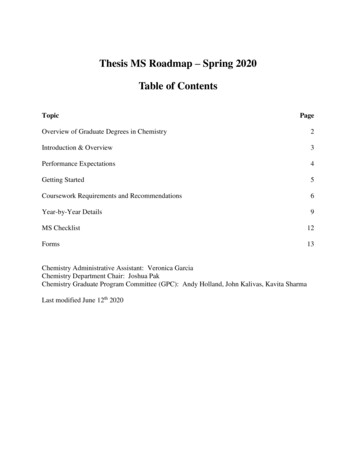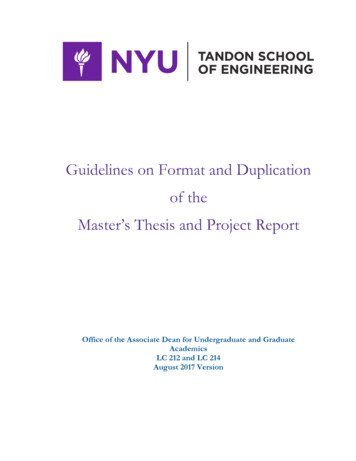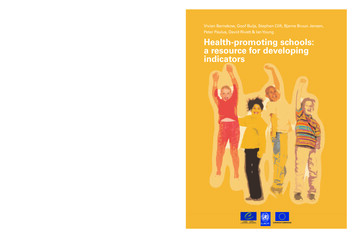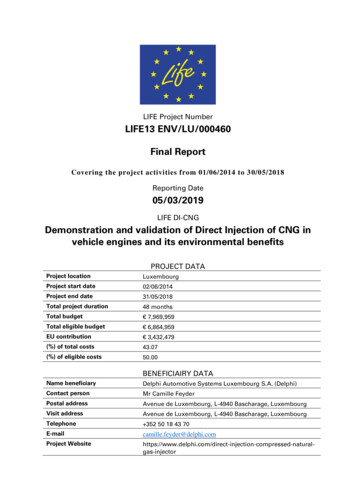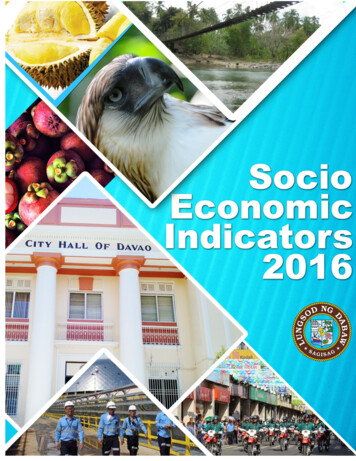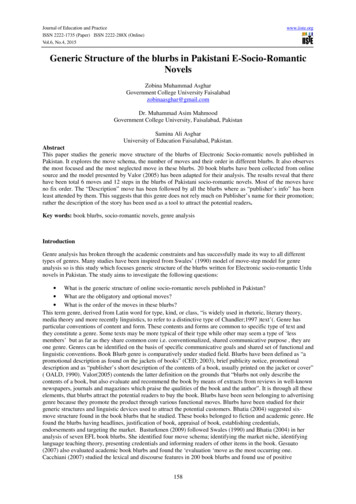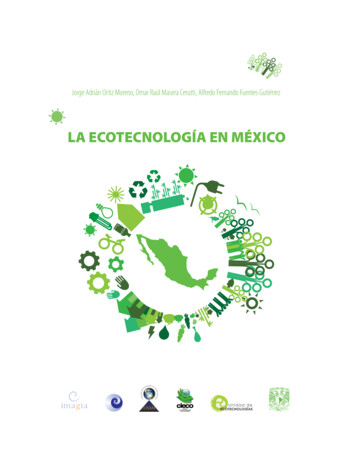
Transcription
LINKÖPING UNIVERSITYDEPARTMENT OF MANAGEMENT AND ECONOMICSMSc INTERNATIONAL & EUROPEAN RELATIONSMASTER’S THESIS:PROMOTING SOCIO-ECONOMIC DEVELOPMENT THROUGHREGIONAL INTEGRATION – THE POLITICS OF REGIONALECONOMIC COMMUNITIES IN AFRICAAuthor: Gaudence NyirabikaliSupervisor: Associate Professor Per JanssonJune 20051
R E G I O N A LI N T E G R A T I O NAfrica’s multiple regional economic groupsTunisiaUMAMoroccoUMACape VerdeECOWASLibyanArab COWASLiberiaECOWAS, MRUTogoBeninSierra LeoneECOWAS, MRUCôte d‘IvoireBurkinaFasoECOWASUEMOAGhanaECOWASasoaF Skin WA AruB CO OE OWASUEMOAEquatorial GuineaCEEAC, CEMACCEPLGCommunauté Economique etMonétaire d’Afrique CentraleCentralAfrican RepublicCEEAC, CEast African CooperationECOWASEconomic Community ofWest African StatesIGADIntergovernmental Authority for DevelopmentIOCIndian Ocean CommissionMRUMano River UnionSACUSouthern African Customs UnionSADCSouthern African Development CommunityUEMOAUnion Economique etMonétaire Ouest-AfricaineUMAUnion du Maghreb ArabCOMESAEACIGAD}CEEAC RwandaCEPLG MESAIOC, SADCUnited Republicof TanzaniaCOMESAEACSADCSeychellesCOMESA, uth dagascarCOMESAIOCCOMESAIOC, SADC}Common Market for Easternand Southern AfricaUgandaDemocratic Republicof CongoZ ItECEEAC, CEPLGCOMESA, SADCCongoCommunauté Economique desPays des Grands LacsCOMESAEthiopiaCOMESAIGAD}CEMACCommunauté Economique desEtats de l’Afrique dCEEACCEMACNigeriaECOWASECOWASUEMOASao Toméand MESA, IOCSACU, SADCLesothoSACU, SADC* Boxed islands not to scaleThe boundaries and names shown on this map do not implyofficial endorsement or acceptance by the United Nations.Source: UN Africa RecoverySEPTEMBER 2002Source: Africa Recovery, September 2002. (Available at: /map.pdf )2
TABLE OF CONTENTSABBREVIATIONS .ABSTRACT .56ACKNOWLEDGEMENTS .7CHAPTER I: INTRODUCTION1.1. THE CONCEPT OF REGIONAL INTEGRATION IN INTERNATIONALPOLITICAL ECONOMY 1.2. REGIONAL INTEGRATION AND THE SOCIO-ECONOMICSITUATION IN AFRICA 1.3. PURPOSE OF THE STUDY AND RESEARCH QUESTIONS 1.4. PLAN OF THE STUDY .891112CHAPTER II: THEORETICAL ORIENTATION AND METHODOLOGY2.1. CLASSICAL THEORIES IN REGIONAL INTEGRATION 2.1.1. FUNCTIONALISM .2.1.2. NEO-FUNCTIONALISM .2.1.3. NEW INSTITUTIONALISM 2.1.4. TRANSACTIONALISM .2.1.5. FEDERALISM .2.1.6. INTERGOVERNMENTALISM .2.1.7. REALISM (NEO-REALISM) .13131314141414142.2. THE NEW REGIONALISMS APPROACH .2.3. COLLECTIVE IDENTITY FORMATION .2.4. SPECIFICATION OF RESEARCH PARAMETERS .2.4.1. POLITICAL STRUCTURES 2.4.2. SECURITY ARRANGEMENTS .2.4.3. ECONOMIC DYNAMICS .2.4.4. REGIONAL GOVERNANCE 151718181819192.5. DELIMITATIONS OF THE STUDY 2.6. RESEARCH DESIGN AND METHODOLOGY .2.6.1. RESEARCH DESIGN .2.6.2. DATA COLLECTION 2.6.3. DATA ANALYSIS .1919192020CHAPTER III: OVERVIEW OF REGIONAL ECONOMIC COMMUNITIES3.1. NORTH AFRICA REGIONAL ECONOMIC COMMUNITY .3.2. SOUTHERN AFRICA REGIONAL ECONOMIC COMMUNITY .3.3. WEST AFRICA REGIONAL ECONOMIC COMMUNITY .3.4. CENTRAL AFRICA REGIONAL ECONOMIC COMMUNITY .3.5. EAST AFRICA REGIONAL ECONOMIC COMMUNITY .3.6. SELECTION OF A REGIONAL ECONOMIC COMMUNITY FORTHE STUDY .222325262829CHAPTER IV: DEVELOPMENT REGIONALISM IN THE SOUTHERNAFRICAN DEVELOPMENT COMMUNITY (SADC)4.1. EVOLUTION OF THE COMMUNITY .313
4.2. POLITICAL STRUCTURES WITHIN THE SADC REGION .4.3. SECURITY ARRANGEMENTS 32334.4. THE SADC’S ECONOMIC DYNAMICS .4.4.1. DEVELOPMENT OF THE REGIONAL MARKET 4.4.1.1. Intra-regional Market 4.4.1.2. Extra-regional Market 343435384.4.2. ORGANISATION OF PRODUCTION 4.4.2.1. Mining 4.4.2.2. Agriculture and Related natural resources .4.4.2.3. Industry .393939404.4.3. REGIONAL INFRASTRUCTURE AND SERVICES DEVELOPMENT4.4.3.1. Regional cooperation in Transport and Communications .4.4.3.2. Regional cooperation in the Energy sector .4.4.3.3. Regional Water Management .4.4.3.4. Regional cooperation in Tourism .41424242434.4.4. COOPERATION IN FINANCE AND INVESTMENT 4.4.5. COOPERATION IN SOCIAL AND HUMAN DEVELOPMENT .43434.5. REGIONAL GOVERNANCE .4.6. COLLECTIVE IDENTITY FORMATION .4545CHAPTER V: THE ACTUAL LEVELS OF REGIONAL INTEGRATION INTHE SOUTHERN AFRICAN DEVELOPMENT COMMUNITY5.1. REGIONAL POLITICAL AND SECURITY ARRANGEMENTS .5.2. REGIONAL GOVERNANCE AND COLLECTIVE IDENTITYFORMATION 5.3. REGIONAL SOCIO-ECONOMIC COOPERATION .5.3.1. GENERAL PERFORMANCE TOWARDS ACHIEVINGREGIONAL ECONOMIC STRATEGIES 5.3.2. LIBERALISATION AND REGIONAL ECONOMIC COMPLEXITIES5.3.3. IMPACT OF EXTERNAL AGREEMENTS ON THE REGIONALINTEGRATION PROCESS .474848485051CHAPTER VI: PLAUSIBLE WAYS OF DEEPENING THE REGIONALINTEGRATION PROCESS IN THE SADC6.1. PLAUSIBLE INTRA-REGIONAL STRATEGIES 6.2. EPAs AND SOCIO-ECONOMIC DEVELOPMENT 6.3. EPAs AND REGIONAL INTEGRATION .525354CHAPTER VII: CONCLUSIONS7.1. LEVELS OF REGIONNESS IN THE SADC COMMUNITY 7.2. PLAUSIBLE WAYS OF DEEPENING THE REGIONAL INTEGRATIONPROCESS 7.3. FUTURE RESEARCH .565758REFERENCES4
ABBREVIATIONSACPAfrican, Caribbean and Pacific Group of CountriesAGOAAfrican Growth and Opportunity ActASEANAssociation of Southeast Asian NationsAUAfrican UnionCEMACCommunauté Economique et Monetaire de l’Afrique CentraleCFACommon Franc AreaCOMESA Common Market for Eastern and Southern AfricaDRCDemocratic Republic of CongoEACEast African CommunityECEuropean CommunityECCASEconomic Community of Central African StatesECOWAS Economic Community of West African StatesEPAEconomic Partnership AgreementESAEastern and Southern AfricaEUEuropean UnionFDIForeign Direct InvestmentFTAFree Trade AgreementGATSGeneral Agreement on Trade in ServicesGDPGross Domestic ProductGSPGeneralised System of PreferencesHIV/AIDS Human Immunodeficiency Virus/Acquired Immune Deficiency SyndromeHSGICHeads of State and Government Implementation CommitteeIGADIntergovernmental Authority on DevelopmentIMFInternational Monetary FundMERCOSUR Mercado Común del SurMISAMedia Institute of Southern AfricaNANot ApplicableNAFTANorth American Free Trade AgreementNEPADNew Partnership for Africa’s DevelopmentOAUOrganisation for African UnityRECSRegional Economic CommunitiesRETOSA Regional Tourism Organisation of Southern AfricaSA/RSASouth Africa/Republic of South AfricaSADCSouthern African Development CommunitySADCCSouthern African Development Coordination ConferenceSA-TDCA South African Trade and Development Cooperation AgreementSACUSouthern African Customs UnionSSASub Saharan AfricaSIPOStrategic Indicative Plan for the Organ on Politics, Defence andSecurity CooperationSPSSanitary and Phyto-sanitary StandardsTBTTechnical Barriers to TradeTRIPSTrade Related Aspects of Intellectual Property RightsTRIMSTrade Related Investments MeasuresUMAUnion du Maghreb ArabUNUnited NationsUNECAUnited Nations Economic Commission for AfricaUNDPUnited Nations Development ProgramUNU/WIDER United Nations University/World Institute for Development Economic ResearchUS/USAUnited States/ United States of AmericaWTOWorld Trade Organisation5
ABSTRACTRegional integration has gained momentum since the 1980s and throughout the world. The newregionalism process prevailing since differs from the old one by its multidimensionality coveringeconomic, political, social, and cultural issues within a regional setting. While the old regionalismfocused on market protection using a range of tariff and non tariff barriers, the New Regionalism isreinforced by the globalisation effects and strives for efficiency in production, and market access.Using the New Regionalisms Approach, the aim of this thesis is to appreciate the actual levels ofregional integration in Africa and explore plausible ways of deepening the integration process withthe view that regional integration can promote socio-economic development, provided a prodevelopment approach is privileged in the conception and implementation of the regionalintegration process. Focusing on SADC as a representative regional economic community, aqualitative content analysis is used for data collection while policy analysis is carried out using theInstitutional Analysis and Development framework. The results of this study reveal discrepanciesbetween policy formulation and policy implementation when it comes to enhancing the prodevelopmental aspects in the unfolding regional integration process. In spite that shortcomings inpast experiences triggered dramatic structural reforms ranging from the reorganisation of theOrganisation of African Unity into the African Union, the creation of NEPAD, to structuralreforms within regional economic communities with the example of the 2001 restructuring ofSADC, empirical evidence shows that little change has occurred at the operational level.Moreover, even policy formulation at the collective-action level still lacks concrete strategies andplans for harmonisation and implementation of regional initiatives. Some of the strategies fordeepening the regional integration process would include prioritising regional commitments toexternal ones and improving policy formulation as well as establishing linkages between differentregional policies and strategies.Keywords: Regional integration; socio-economic development; development regionalism; peaceand security; regional economic community; SADC.6
ACKNOWLEDGEMENTSMy profound gratitude goes first to Professor Geoffrey D. Gooch, the director of the Internationaland European Relations programme at the Linköping University, who understood my thirst forupgrading my education. Special thanks are due to Associate Professor Per Jansson, who kindlyand professionally guided the accomplishment of this thesis. I would also like to thank all thelecturers on the programme, and particularly Kerstin Karlsson for her always helping hand in alladministrative and technical situations.I am deeply indebted to the EUROSTEP management team composed of Simon Stocker, FlorentSebban, and Yvette Pierret for their openhearted support and orientation during my internshipwhich permitted to access invaluable material for this research. My profound gratitude also goes toDavid Jacobs for his encouragement and provision of a great number of course literature books.May my friends Seden Tezcan, Xiaohong Ye and Isis Marie whom we shared both academic andother constructive thoughts, find their own expression through this work.Last but not the least I would like to dedicate this work to Remmy, Adelaide, Lambert, and Aubin,my greatest wonders that stood by me along all my university studies. May the efforts invested bean encouragement in their own lives to always strive ahead, no matter the magnitude of setbacksencountered.Gaudence NyirabikaliJune 20057
PROMOTING SOCIO-ECONOMIC DEVELOPMENT THROUGHREGIONAL INTEGRATION – THE POLITICS OF REGIONALECONOMIC COMMUNITIES IN AFRICACHAPTER I: INTRODUCTION1.1. THE CONCEPT OF REGIONAL INTEGRATION IN INTERNATIONALPOLITICAL ECONOMYRegional integration as a concept and process developed in the 1950s following the creation of theEuropean Economic Communities. As a process, regional integration refers to a voluntarycollective action among states within a geographical proximity to economically and politicallyharmonise policies, production, and trade issues with a view of optimising efforts in addressingnational and regional challenges, the end result being an economic and political community. Theexistence of peaceful relationships among regional members is a prerequisite to the developmentof a regional integration process which in turn, reinforces the security community. The intenseinternational cooperation which takes place in a regional integration process requires asupranational decision making and a certain level of institutionalisation. As the concept and itspractice evolved with time, different definitions were provided by different scholars. For example,Reginald Harrison, in the same line of thinking as Ernst Haas (1971:4), defined the integrationprocess as “the attainment within an area of the bonds of political community, of centralinstitutions with binding decision-making powers and methods of control determining theallocation of values at the regional level and also of adequate consensus-formation mechanisms”1whereas William Wallace adopted a more generalised definition as “the creation and maintenanceof intense and diversified patterns of interaction among previously autonomous units”.2The early regionalisation of the 1950s and 1960s focused mainly on technical and economicfactors, with a view that economic growth would ensure peace and the welfare of societies. Butfrom the 1970s, empirical evidence increasingly pointed out that economic factors alone were notsufficient to ensuring growth as “economic stagnation fed political strife while political conflictexacerbated economic uncertainty”.3 Hence the 1970s and 1980s saw the resurgence of politicaleconomy and the birth of the New Regionalism which differs from the old one by itsmultidimensionality and comprehensiveness in the combination of both economic and politicalfactors. With its focus on economics and politics at regional level, regional integration stands as asubfield within international political economy, which itself, is a social science concerned with“the interplay of economics and politics in the world arena”.4 Within this context, “regionalintegration as an instance of regionalism in the global political economy, aims at offeringreflections upon and possibly generalisations about the tendency of groups of territorially adjacentstates to cluster together into blocs”.5 The European Union (EU), the North American Free TradeAgreement (NAFTA), the Association of South East Asian Nations (ASEAN), MERCOSUR inSouth America, etc, are examples of such blocs. Whereas conceptualisation and practice evolvedwith time, the general objective of regional integration has remained the same: ensuring peace andthe welfare of societies. Regional integration’s concern for the welfare of societies also makes itextendable into development studies and usable as a development strategy, as it is the case in thisstudy.1Harrison (1974:14) in Rosamond, Ben (2000), Theories of European Integration. Houndmills: Palgrave, p. 12.Wallace (1990: 9) in Rosamond, op. cit., p. 13.3Frieden, Jeffrey A. & Lake, David A. (2000), International Political Economy: Perspectives on Global Wealthand Power. NewYork: Bedford and St. Martin’s, p. 4.4Ibid., p. 1.5Rosamond, Ben (2000), Theories of European Integration. Houndmills: Palgrave, p. 15.28
Here again, development and specifically socio-economic development is considered in its broadersense as defined by Amartya Sen, as “an integrated process of expansion of substantive freedomsinterconnecting with one another”; those freedoms being identified as “political freedoms,economic facilities, social opportunities, transparency guarantees and protective security”.61.2. REGIONAL INTEGRATION AND THE SOCIO-ECONOMIC SITUATIONIN AFRICAOn the African Continent, efforts of regionalisation started with the independence era, specificallywith the creation of the Organisation of African Unity (OAU) in 1964. Together with the UnitedNations Economic Commission for Africa (UNECA), these two organisations sustained regionalefforts throughout the continent, with the collaboration of other bilateral aid especially fromformer colonial powers in the different regions. The most significant effort in this regard was thecreation under the OAU, of regional economic communities (RECS) through the Abuja Treaty(Nigeria) in 1991. The seven regional economic communities were conceived as building blocs ofthe African Economic Community. With the reorganisation of the OAU into the African Unionand the creation of the New Partnership for Africa’s Development (NEPAD) in 2001, the RECSwere maintained and designated to serve as implementing agencies for NEPAD’s programs.Concerning the socio-economic development, neither the regionalisation efforts nor otherstructural adjustment programs undertaken from the 1980s did improve the African economies,which “at the dawn of the twenty-first century, most of sub-Saharan Africa remained mired ineconomic crisis despite two decades of donor-sponsored reform efforts. Most economies in theregion still have not overcome the fiscal and balance of payments deficits that have underminedeconomic stability since the first oil crisis in the mid-1970s”7. Beside the globalisation’s negativeimpacts on the African economies, other often incriminated obstacles to socio-economicdevelopment are the state’s limited capacity to implementing development policies, endemiccorruption, inadequate public infrastructure, the quality of physical and human capital, and thedeterioration of security. During the twenty years of structural adjustments supported by the IMFand the World Bank, the most criticised causes were high government expenditures, high levels ofinflation and protectionist trade policies. Although opposing critics were against the harshconditions imposed by those international financial institutions to the poor local populations, thedifferent views about African situation were however unanimous on the need of basicmacroeconomic stability to ensure economic growth. While other developing countriesexperienced impressing development levels after their independences (East Asian and some LatinAmerican countries) through advantages of foreign direct investment and the spread ofliberalisation, Africa’s poor performance has instead reinforced its progressive marginalisationfrom the global economy, where its share, according to the World Bank’s report 1998, amountedonly at 1.1 percent of the world’s GDP.8 From this scenario, the general view is that appropriatepolicies, especially policies capturing African characteristics, are still needed for the socioeconomic development of the continent. Besides the economic factors, Van de Walle points outthat “variables such as the level of corruption, the extent of ethnic fragmentation, the level ofpolitical violence, or the quality of government services help explain the growth differentialbetween Africa and other regions”.9 Since African governments’ incapacity in implementingpolicy changes is identified as part of the problems, a plausible way around such a situation is ofimplementing the required policy changes through regional organisations. The need for a regionalintervention is reinforced by the globalisation’s effects that further undermine the alreadyinconsistent national governments’ ability to manage their economies. Since the 1980s,developments in the world affairs such as the complexity in international economic negotiations,6Sen, Amartya (1999), Development as Freedom. New York: Anchor Books Edition; p. 8 & 10.Van de Walle, Nicolas (2001), African Economies and the Politics of Permanent Crisis, 1979-1999.Cambridge: Cambridge University Press, p. 3.8Ibid., p. 6.9Ibid., p. 11.79
intensification of international economic competition and rapid technological developments, aswell as political problems in terms of peace and security are identified as factors behind the spreadof regional arrangements. While consensus and cooperation among developed market economiesis strengthened by common interests and economic interdependence, the cooperation imperativefor the developing countries is further enhanced by the need for increased bargaining power ininternational economic decisions, as “increasing fragmentation of the South constitutes an obstacleto its ability to place demands for equity on the international agenda”.10 Furthermore, “withoutextensive internal political, social, and economic reform in the Less Developed Countries,international efforts at redistribution and development will be useless, according to many in boththe North and the South”.11 In his studies of Regionalisation, Morten Boås affirms in this regardthat “if Africa is not regionalised, it will be further marginalised: African states will not survive ontheir own in a highly competitive global economy”.12 It is out of such a state of affairs thatAfrican leaders reorganised the OAU into the African Union and created the New Partnership forAfrica’s Development (NEPAD).Under the umbrella of the African Union, the main objective of NEPAD is of providing “animpetus to the continent’s development by bridging existing gaps between Africa and thedeveloped world, not only through securing financing for a broad range of projects and a boost inthe access to international markets for African exports, but also eradicate widespread poverty,facilitate private investment in Africa, secure further measures on debt relief and higher levels ofaid in priority sectors for development”.13 Whereas NEPAD’s programs can be incorporated innational development plans of member countries, the implementation of those programs is carriedout through already existing regional development organisations and coordinated through RegionalEconomic Communities (RECS) that existed previously under the African Economic Community,a framework of the OAU (at present, the African Union). NEPAD being the new socio-economicdevelopment framework of the African Union, the regional economic communities serve asbuilding blocks within the NEPAD’s framework and operate under the NEPAD Heads of State andGovernment Implementation Committee (HSGIC).The sub-continental organisation under the HSGIC is as follows: West Africa, North Africa,Central Africa, East Africa, Southern Africa and Madagascar.14Besides the legitimate goal of developing the African continent, NEPAD seems also falling inplace as a response to the imperatives of the new world order – globalisation and regionalisation.As strong economies of developed countries dominate the world market African countries withtheir non competitive products lose not only the little share they disposed at the internationalmarket, but also the local market which becomes overflowed with imports from more competitiveproducers. African exports losing both value and market, the income decreases while the levels ofexpenditure increase including the debt burden. To the above scenario is added among otherthings, environmental and security issues. When considering difficulties inherent to globalisation,regionalisation becomes almost a panacea in tackling those negative effects, as for small and poorcountries it appears the best way of increasing their bargaining power, reorganising production andinvestment, environmental and resource management, etc. In this regard and through hisregionalism discourse, Björn Hettne demonstrates that development regionalism as a strategy inthe regionalisation process could promote peace and socio-economic development. His argumentsare summarised in seven crucial points as follows: regional cooperation allows the micro-states to10Spero, Joan E. & Hart, Jeffrey A. (2003), The Politics of International Economic Relations, 6th Edition.New York: St. Martin’s, p. 393.11Ibid., p. 394.12Boås, Morten, “Regions and Regionalisation: A heretic’s view” in Regionalism and Regional Integration inAfrica: A Debate of Current Aspects and Issues. Discussion Paper 11, Nordic Africa Institute (2001),Uppsala: Sweden, p.29.13Copyright NEPAD 2002; accessed on 26th September 2003. www.nepad.org: Copyright NEPAD 2002.10
solve many common problems rather difficult to overcome on an individual basis; it alsoconstitutes a reliable development strategy if the regional cooperation encompasses coordinationof production, improvement of infrastructure and a search for complementarities; the stability andconsistency of economic policies underpinned by regional arrangements become an importantfactor in attracting foreign investment; a collective bargaining on a regional level improves theeconomic position of marginalised countries in the negotiation and establishment of raw materialprices and market access for their emerging exports; regionalism sustains the viability of societiesby including in the regional organisation social security issues, such as the establishment ofdevelopment funds to reduce on development disparities within a region; regional cooperationfacilitates the management of shared environmental complexities. And last but not the least,regional cooperation improves the settlement and prevention of regional conflicts thus eliminatingdistorted investment patterns as resources previously allocated to military expenditures can beused for investment and economic production.15A regional integration process encompassing economic, political and social integration also standshigh among the objectives of the African Union as stressed out by his Chairperson, PresidentThabo Mbeki, at the launch of the Union: “The first task is to achieve unity, solidarity, cohesion,cooperation among peoples of Africa and African states. We must build all the institutionsnecessary to deepen political, economic and social integration of the African continent. We mustdeepen the culture of collective action in Africa and in our relations with the rest of the world”.16President Mbeki also added that sustainable development in Africa was to be conditioned bypeace, security and stability, variables requiring a collective action from the African continent. Inaddition to the unification and development of the continent, the other concern of the Union is ofovercoming the marginalisation of the African continent within the globalisation process. Anintegrated Africa as a foundation and a way of redressing the African underdevelopment andmarginalisation is not only a vision of leaders but also a consensus among the African communityat large as expressed by most contributors in a publication of the Nordic Africa Institute onAfrican visions.17 This awareness among the common people of Africa lifts up the importance ofregional integration in Africa as a domain of research whilst it also offers a solid base to build onfor the promotion of regional integration.1.3. PURPOSE OF THE STUDY AND RESEARCH QUESTIONSNEPAD is a very young organisation set up with the assumption of being the ultimate organisationthat should nurture the development of the African Continent, especially after the failure of somany other initiatives that had the same ambition. In order for NEPAD to avoid the same fate asits predecessors, the primary prerequisite condition is a mutual understanding and cooperation ofmember states to NEPAD’s programs. The literature review as presented above also suggests thatthe current African political economy calls for a regional integration process if the continent is torecover from its economic crises and redress the marginalisation process it is faced with in theglobal economy. In this regard, regional integration is adopted by both the African Union and theNEPAD as a recommendable way to the development of the African continent, while Hettne’sapproach of Development regionalism shows how regional integration as a development strategy,can help address the current problems in the African context.As extensive theoretical works have explained how a regional integration process could promotesocio-economic development, the present study is thus concerned with investigating on how thesetheoretical works are reflected in the regional integration process unfolding on the Africancontinent. By assessing the achieved levels of regional integration in the NEPAD’s regional15Hettne, B. et al. (2001), Comparing regionalisms – Implications for Global Development. Houndmills:Palgrave, pp. 16-19.16Address by President Thabo Mbeki, Chairperson of the African Union. Durban, South Africa, 9th July 2002.17Adesida, Olugbenga & Oteh, Arunma (2001), African Voices, African Visions. The Nordic Africa Institute,Uppsala: Sweden.11
economic communities, theoretical reflections on the interaction of respective actors, policyformulation, and policy implementation can then offer critical insights for a more rationalisedimplementation of the integration process, as well as plausible strategies for deepening thatprocess. This study would make a contribution to the understanding of how theory and practice aremanaged in the ongoing integration process in Africa. Therefore the current research will beguided by the following questions:1. What levels of regionness have been achieved in the African regional integrationprocess?2. What are the plausible strategies that can move this process further on the integrationspectrum?The term regionness is borrowed from the authors of the UNU/WIDER - New Regionalism seriesand means the degree of coherence and homogeneity in a particular region, with regard to certainaspects of the political, social and economic dimensions.Regional integration is considered in i
linkÖping university department of management and economics msc international & european relations master's thesis: promoting socio-economic development through
